Tapestries
Textiles remain a constant that have woven together cultures across time. While the fibers and designs may evolve or differ, textiles have connected people across places, illustrating regional artistry and innovation.
Historically and technically, the term “tapestry” designates a weft-faced (threads moving along the width) textile woven by hand on a loom, the design of which includes various or a single figure. While their history dates back to Ancient Greece and China, those created during Medieval and Renaissance Europe remain most popular. The Nichols House Museum is home to three such pieces.
Starting in the early fourteenth century, a sizable industry capable of producing a steady volume of large, high-quality tapestries developed in the towns of northern France and the southern Netherlands. Local guilds, availability of skilled weavers and dyers, as well as commissions by local patrons, encouraged the development of this budding industry, and by the mid-fifteenth century, numerous tapestry workshops existed in the Low Countries. From these towns of production, tapestries were then exported all over Europe.
As these pieces were created as large-scale wall decoration, medieval tapestries were often hung with sections obscured by furniture and architectural features. This encouraged the development of a specific design style which allowed the narrative to be spread over the entire surface. Royalty and noble families could roll up and transport tapestries from one residence to another. In churches, they would be displayed on special occasions. Tapestries were also draped on the walls of castles for insulation during winter, as well as for decorative display, as a piece of art or as political importance with the use of emblems, family crests or mottos.
A tapestry is made by repeatedly weaving the horizontal (weft) threads over and under the vertical (warp) threads, then squishing (or tamping) those horizontal threads down so they are very close together, thus completely hiding the vertical threads from view.
The Nichols House Museum is home to multiple Flemish tapestries, the oldest dating to the mid-sixteenth and early seventeenth century. This tapestry (1961.192) is representative of the popular “Feuilles de Choux” (leaf of cabbage) or Verdure style, showing foliage and animals. As there is no central point of action, the viewer is encouraged to take in the scene as a garden or forest. Verdure tapestries are among the earliest depictions of New World topography, often inserting popular mythical animals as well. Animals not native to Europe, such as the camel on the left side, were depicted from print sources. The unicorn, griffin, and manticore were popular medieval subjects along with the other non-mythical animals depicted: buzzards, leopards, deer, and horses. The use of oversized foliage in lush landscape, with cottages and castles in the background, was a common use of imagery as well.
The tapestry itself was created with wool and silk wefts and linen warps, with a weft-faced plain weave and slit-weft. A slit-weft occurs when different colored weft yarns are passed around adjacent warps without linking, so that vertical openings or slits are created, lending the name “slit tapestry” to this kind of weaving. These slits were sometimes a desirable way of adding depth and shadow to the finished piece. Weavers could also sew the slits together or use a technique (as is the case in this piece) called dovetailing to interlock the wefts around a common warp.
Elizabeth Nichols purchased this tapestry in France in 1901 with the encouragement of her brother-in-law, sculptor Augustus Saint-Gaudens (1848-1907). Elizabeth described it as “gothic and very interesting.”
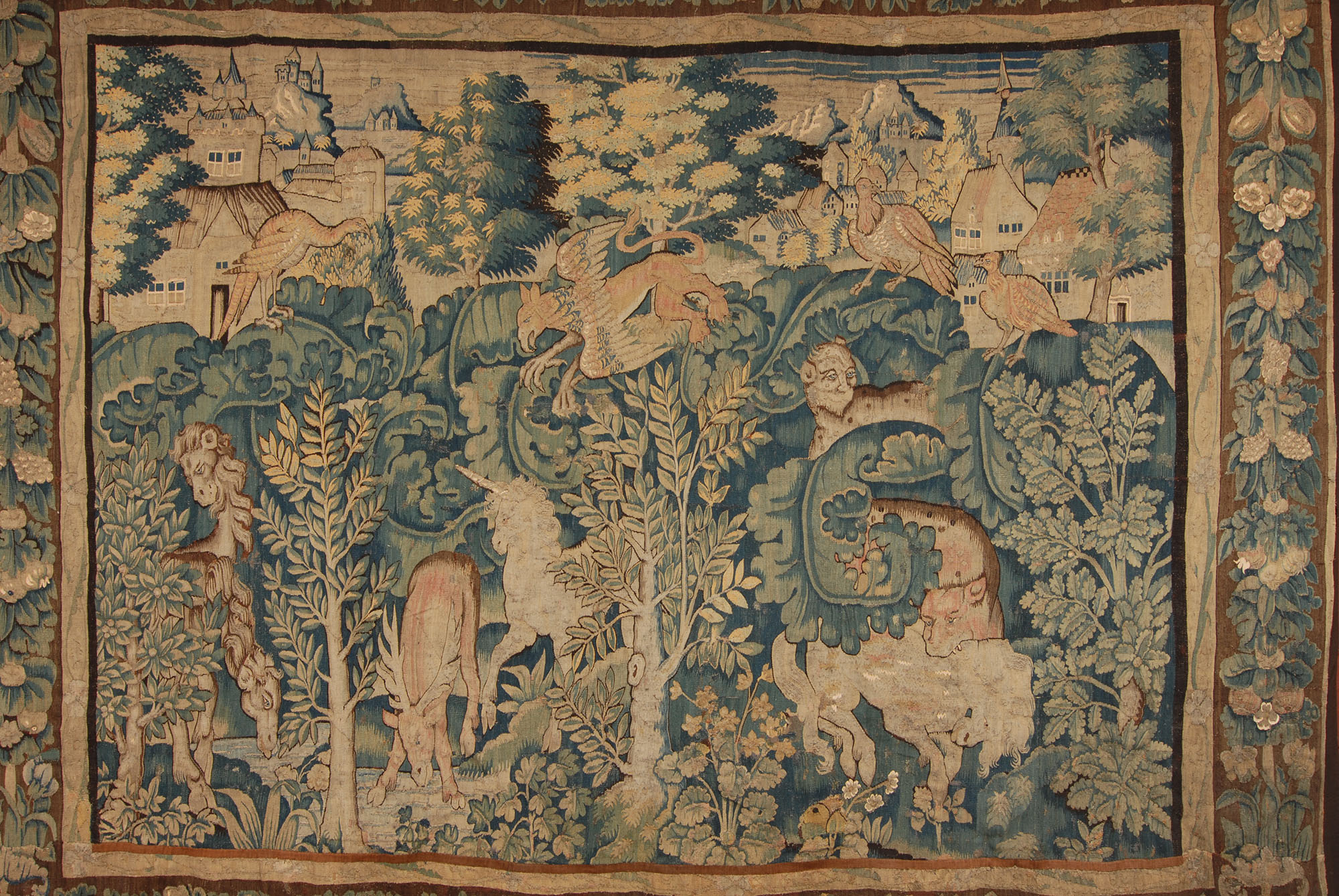
Tapestry, Spanish Netherlands, ca. 1550-1600. Silk, wool, linen. Nichols House Museum, 1961.192.
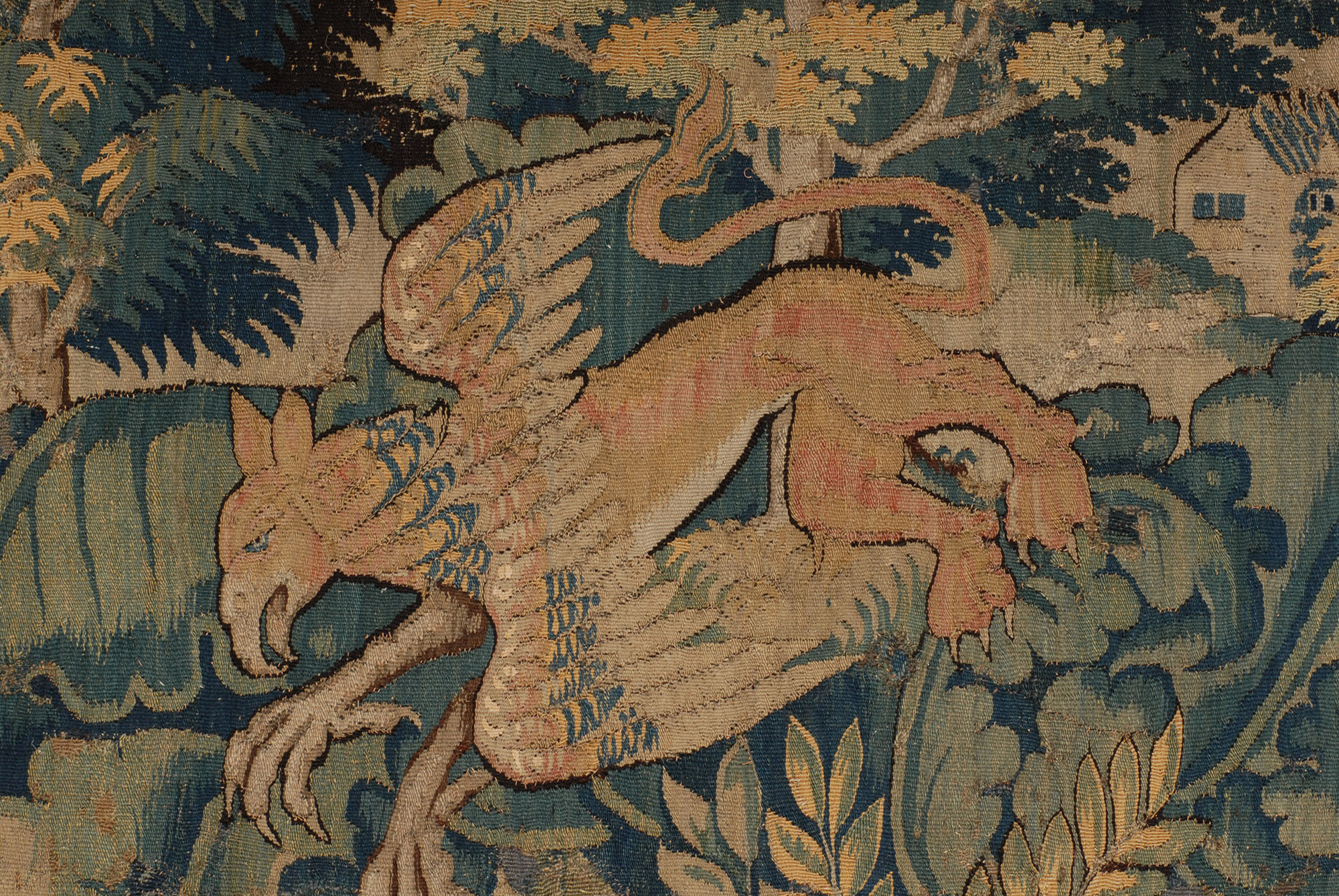
Detail of griffin from Tapestry, 1961.192.
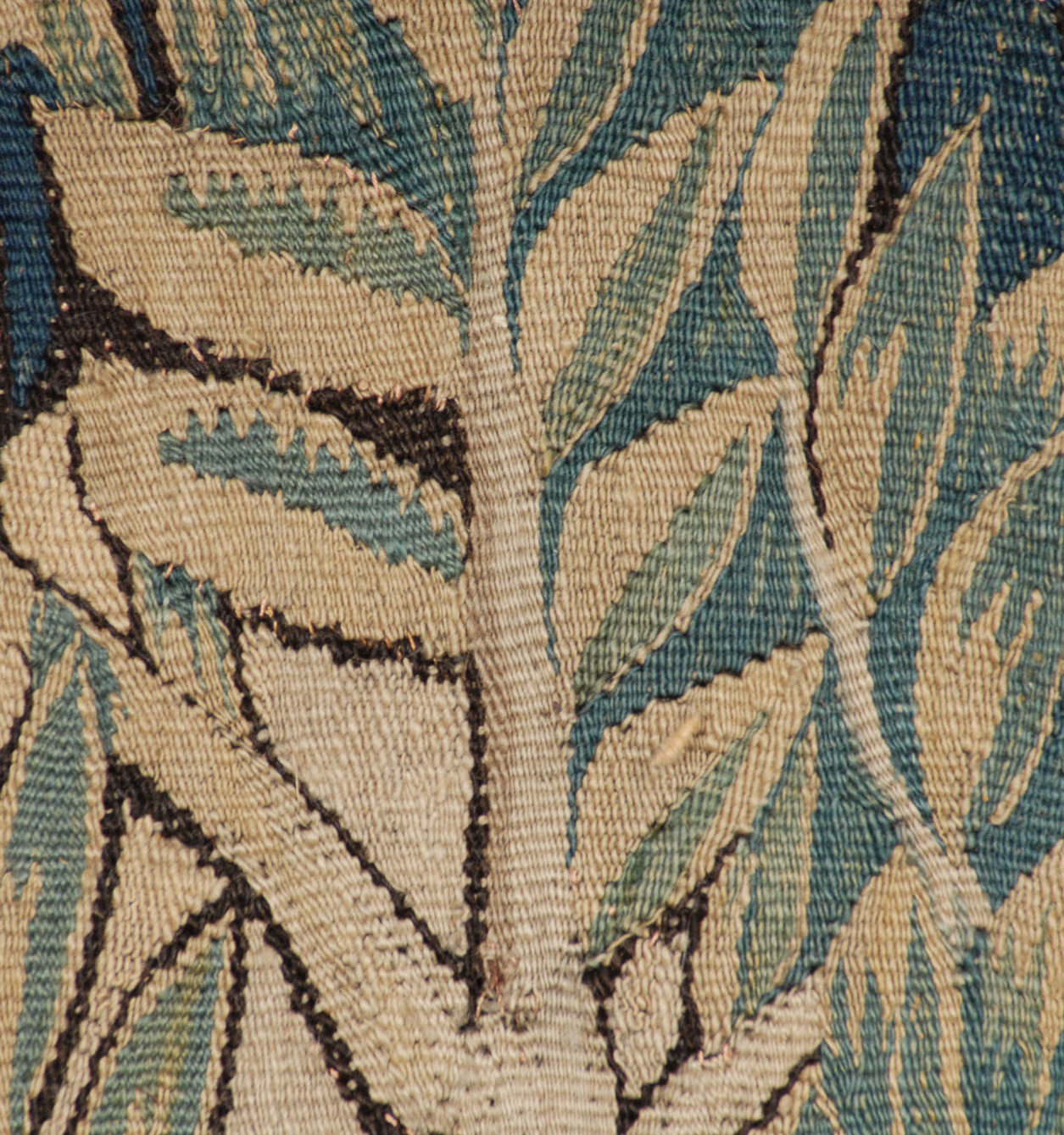
Detail of Tapestry showing the weave, 1961.192.
Needlework and Embroidery
Samplers
Samplers and embroidery were done by girls and women to demonstrate their achievement in the feminine arts. They functioned as both an educational exercise and as a decorative item. By the 18th century, sampler making had become an important part of girls’ education. The alphabet and numbers accompanied various crowns, coronets, or other patterns, all of this training for decorating and marking household linens.
By the late 18th century, schools or academies for well-to-do young women were flourishing. There, they created more elaborate embroidery with decorative motifs such as verses, flowers, houses, religious, pastoral, and mourning scenes. While samplers and pictorial embroidery are often associated with the Colonial period, it remained an integral part of girls’ education as late as the early twentieth century.
In 1911, Rose Nichols created a sampler (1961.538) demonstrating her skill as an embroiderer while paying tribute to the girl who inspired the piece, Rosalia Escolar, who’s 1842 sampler is now in the collection of Museum of Fine Arts, Boston. From the color palette to the missing letters of U, W, and X, Nichols intimately retraced Escolar’s youthful yet skilled hand.
Needlework Embroidery
After creating a sampler for school, a young woman from a wealthy background may have had the opportunity to continue her education in a female academy, honing her skill in creating a larger, more complex work such as this early nineteenth-century mourning embroidery (1961.161). This piece demonstrates satin stitch and French knot embroidery.
The death of George Washington in 1799 inspired a trend of mourning scenes in embroidery. In keeping with the Neoclassical style of the period, the iconography drew inspiration from classical antiquity and included plinths, urns, and trees within a garden landscape.
Mourning scenes were images of both sadness and pride for the family, simultaneously communicating grief and joy in material achievement. Through her skill and labor, a young woman could commemorate the life of a loved one.
Here, the figure of a young woman mourns her three siblings. Her pose echoes the willow tree and her dress falls gently around her in layers. Her arms, face, hair, and the distant background are painted in watercolor, done either by a professional artist or by the teacher. The leaves of the tree and the grass use the same thread colors.
Crewelwork Embroidery
An overall highlight of the Nichols House Museum collection are the bed hangings embroidered by Rose Nichols, ca. 1890 (1961.505). Crewel embroidery, or crewelwork, is any embroidery that uses a fine, strong and worsted wool form of threads known as crewel thread. Crewel embroidery on a linen ground has been used in Europe since the early Medieval period, although the term “crewel,” as far as is known, dates back only to the seventeenth century. Beginning in the 1870s, the revival of this style continued the use of wool threads; however, the background fabric now varies from wool, silk, cotton, to synthetic materials.
These crewelwork bed hangings made by Rose Nichols are comprised of multiple linen twill weave panels with silk lining. Embracing the Colonial Revival, it emulates eighteenth-century Queen Anne floral designs of stylized blossoms and flowers with curved stems and branches. The designs make use of a wool chain stitch, satin stitch, and French knot embroidery in shades of green, brown, gold, pink, blue, and lavender.
Elizabeth Weisblatt
Collections Intern
Spring 2019
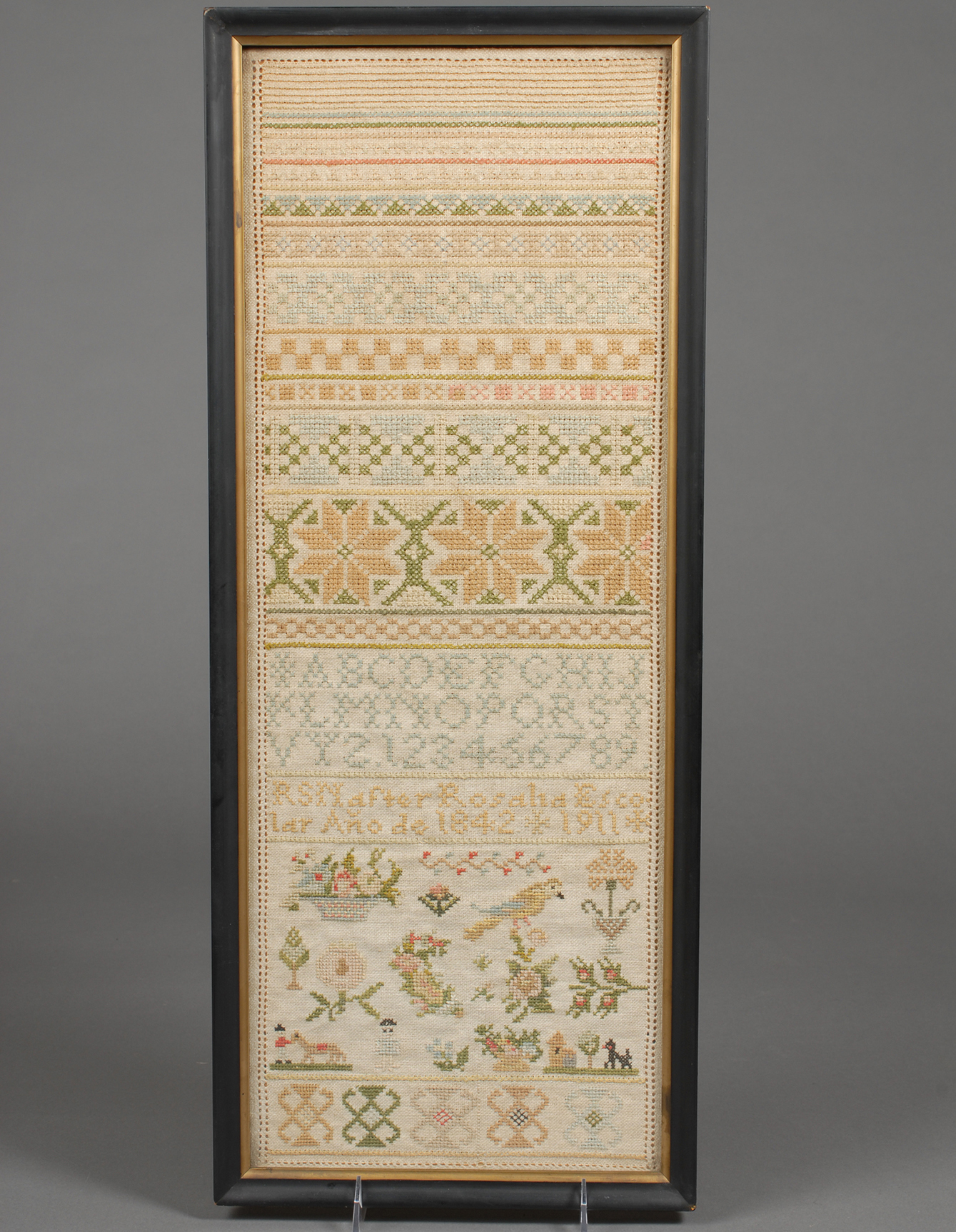
Sampler made by Rose Standish Nichols (American, 1872-1960) after 1842 sampler by Rosalia Escolar (Spanish), 1911. Nichols House Museum, 1961.538.
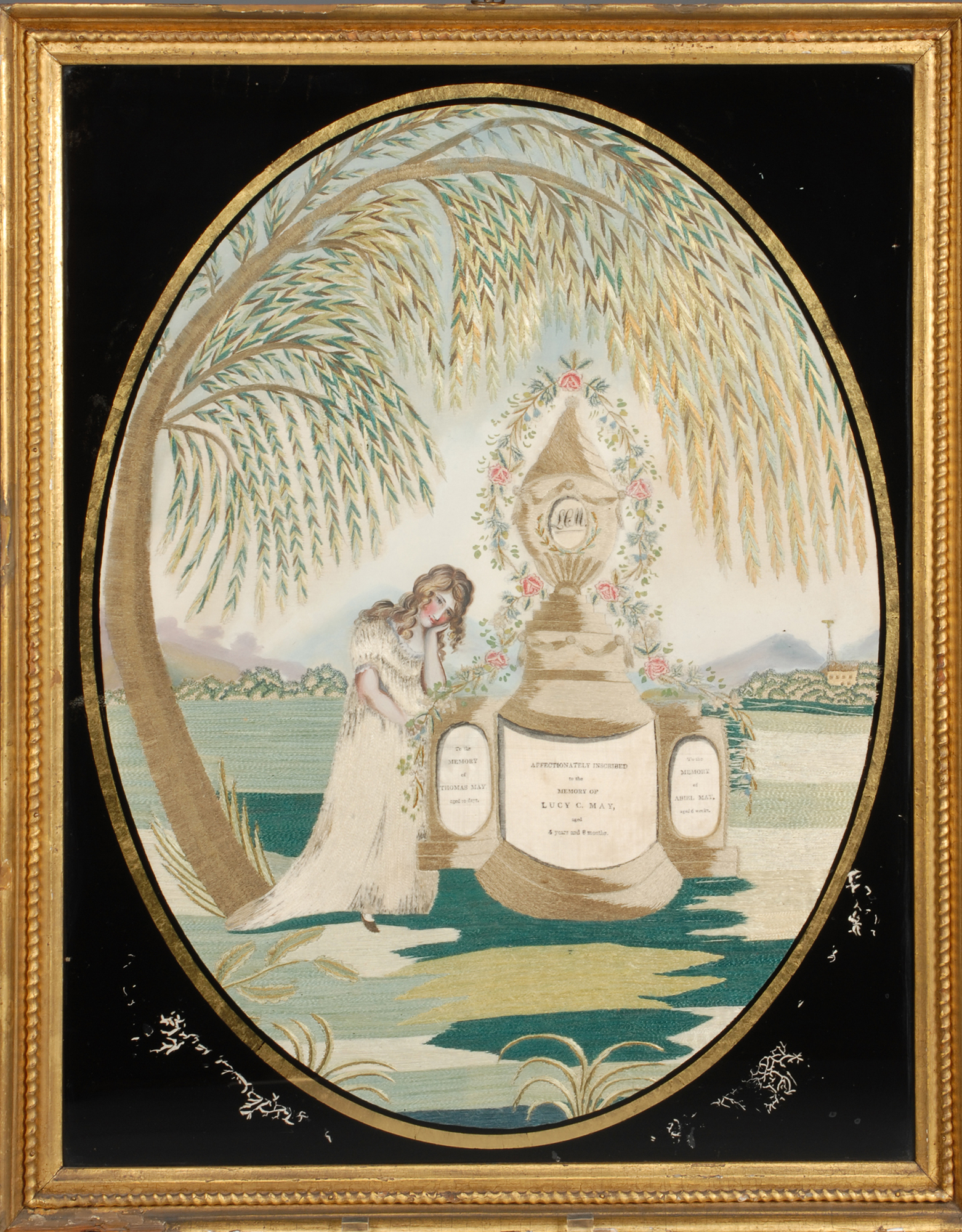
Needlework mourning picture, American, early 19th century. Nichols House Museum, 1961.161.
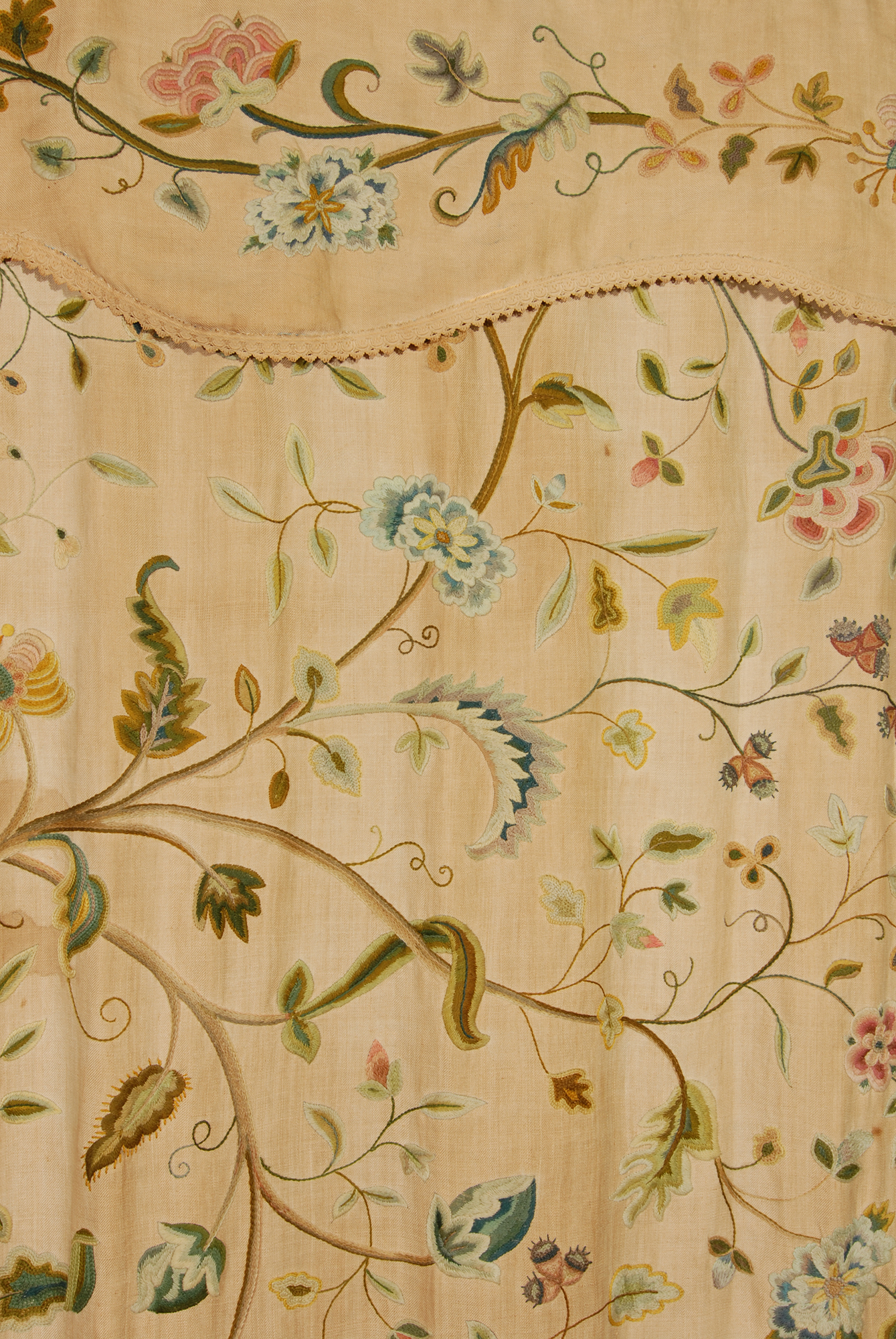
Bed hangings made by Rose Standish Nichols (American, 1872-1960), ca. 1890. Linen and silk. Nichols House Museum, 1961.505.
